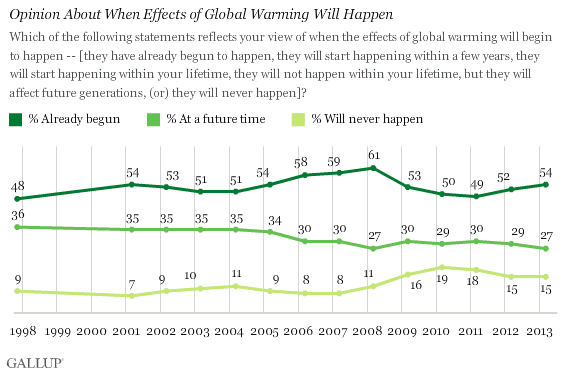Wars and conflicts rage on, the economy fluctuates dangerously, and tragic racial tension consumes the nation, however, while all this is going on before our eyes, a more silent and deadly threat looms in the shadows behind us all. This threat is climate change. Climate change is one of the most pressing concerns of our generation simply because it wasn’t recognized and curbed when the problem was in its infancy. Now, we have begun to slide down a slippery slope and the situation is becoming more drastic. We hear all of the doomsday predictions in the media about how “all the polar bears will die off” and the “ocean levels will rise dramatically.” Now, these are just predictions, perhaps not even ground in hard science, but the point is, there will be consequences. Though, if there are consequences, why does no one seem to care? It may be that many people are just too engrossed in the other issues stated above. In a Gallup poll, last year only 54% of Americans believed the effects of global warming have already begun, with 15% believing they will never happen at all.
But the sad, scientifically validated truth is that the effects are real, however I’m not going to spend this blog talking about the dire consequences or preaching to you about how horrible we are as human beings. Instead, I’m going to share some solutions, from the simple to the complex, from the innovative and creative to the traditional. There are passionate people out there trying to solve the issue while our leaders argue if its even happening. They deserve recognition and you as readers and citizens deserve a rundown of how effective our methods are. After all, its our planet to take care of and we only get one.
I thought we would start with a series on alternative energy. Fossil fuel combustion is a leading factor of global climate change but its simply too cost effective and too much of an ENORMOUS industry to be overshadowed by cleaner fuels. The infrastructure is simply not yet established for renewable energy sources. However, that could very well be changing. One of the most prominent and recognizable forms of alternative energy is wind power. Wind is perfectly clean, it exists practically everywhere, and turbines take up very little land, making it ideal for farmers or ranchers. In fact, wind consumption has risen steadily in the US over the years
Wind power is not without its drawbacks though. The economic hurdle can be a large leap not to mention the impact on the environment. Opponents claim that wind turbines cause noise pollution and are prone to killing flying birds.
(Although it seems a little hypocritical that environmentalists are trying to protect birds over the entire planet’s ecosystem but to each their own I suppose)
But by far the biggest drawback is the nature of the source. It’s not always windy. Great Britain saw the consequences of this phenomenon around the Christmas of 2010 when a sudden cold snap all but shut down their 3,000 turbines, leaving them to rely on coal for most of their power.
Currently, the standard for wind turbines are the Horizontal Axis Wind Turbines (HAWT), the ones that drone and chop birds into pieces, seen here:

From the CQ Researcher article on wind power. Pictured is an 18 turbine farm that completely sustains the small North Dakota town of Velva (pop. 1000).
Innovators are currently trying to solve these problems with creative new designs that will hopefully bring wind power more forcefully into the public sector.
One of the most promising of these inventions is sending the turbines up in the air. Floating a turbine and tethering it to the ground eliminates the inconsistency because it’s pretty much always windy up there. It also eliminates noise pollution and is cheaper to produce. Here is a design from Altaeros Energies:
A crazier idea is the WindStalk. It’s not really a turbine. It is a tall swaying rod sitting on a piezoelectric generator (generates electricity from motion). The creators at Atelier DNA envisioned this to be an artful, classy way of incorporating wind energy into urban areas.
The last major design I’m going to share is more down to Earth, actually, it’s already being done. Offshore wind farms eliminate the eye sore complaint (which I don’t understand), the noise pollution, and most of the bird danger as well as being able to collect more wind. The only problem is that they are waaaaay more expensive because they usually have to anchor them in the ocean floor. This can be solved by floating the turbines instead which is in the development phase.

So what do you guys think? Do the benefits of wind power outway the costs? What kind of innovations should we be considering and funding? Let me know in the comments as well as what kinds of alternative energies/climate change solutions you want me to cover next!



